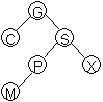Exercises
Binary Search Trees
Read the reading assignment(Litvin 404-419).
- The binary search tree provides us with a structure that allows us O( ) access to any node in the structure - an improvement over the sequential search of a(n) (list which is O(n).)
- A binary tree is a structure in which each node is capable of having successor nodes, called . The unique starting node is called the .
- A node is one that has no children. A node of a binary tree is itself the root of a smaller tree called a . All nodes appearing in a subtree are called of the root node of the tree - conversely, the root node is called an of all nodes appearing below it. The root node of a tree is said to have level . The maximum level in a tree determines its and the level contains at most nodes.
- In a binary search tree, what is true of all nodes in the right subtree of some given node?
- If you want to get ride of an existing tree, the statement
tree = NULL is not recommended.
Why?
- Any node inserted in a binary search tree necessarily comes a node.
- Is the recursive function Find on page 410 a good use of recursion?
Why or why not?
- Minimizing the height of a Binary Search Tree will maximize
- What three cases are considered in developing the Remove function?
- Name the three BST traversals.
- Given the character input ( M G B H S P F C), draw the BST and state the tree traversals.
- In destroying a tree which traversal should be used?
- Which BST traversal lists the info fields of the tree nodes in sorted fashion?
Consider the tree below.

- How many subtrees are shown?
- Insert nodes containing T and N. Redraw the tree.
- After part 15, the trees height is ?
- Name the ancestors of P.
- Interchange all subtrees with their corresponding right subtrees by redrawing the tree again.
Continue to: Unit 8 / Prev / Next

